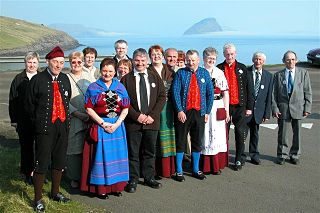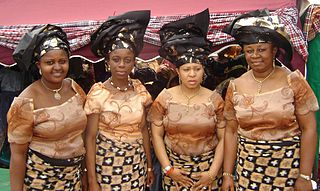
A blouse is a loose-fitting upper garment that was worn by workmen, peasants, artists, women, and children. It is typically gathered at the waist or hips so that it hangs loosely ("blouses") over the wearer's body. Today, the word most commonly refers to a girl's or woman's dress shirt. It can also refer to a man's shirt if it is a loose-fitting style, though it rarely is. Traditionally, the term has been used to refer to a shirt which blouses out or has an unmistakably feminine appearance.

A folk costume expresses an identity through costume, which is usually associated with a geographic area or a period of time in history. It can also indicate social, marital or religious status. If the costume is used to represent the culture or identity of a specific ethnic group, it is usually known as ethnic costume. Such costumes often come in two forms: one for everyday occasions, the other for traditional festivals and formal wear.
Clothing in India is dependent upon the different ethnicity, geography, climate, and cultural traditions of the people of each region of India. Historically, male and female clothing has evolved from simple garments like kaupina, langota, achkan, lungi, sari, gamcha, and loincloths to cover the body into elaborate costumes not only used in daily wear, but also on festive occasions, as well as rituals and dance performances. In urban areas, western clothing is common and uniformly worn by people of all social levels. India also has a great diversity in terms of weaves, fibers, colours, and material of clothing. Sometimes, color codes are followed in clothing based on the religion and ritual concerned. The clothing in India also encompasses the wide variety of Indian embroidery, prints, handwork, embellishment, styles of wearing clothes. A wide mix of Indian traditional clothing and western styles can be seen in India.

The mundu is a garment worn around the waist in the Indian states of Kerala, Tamil Nadu, the Lakshadweep archipelago, and the Indian Ocean island nation of Maldives. It is closely related to sarongs like dhotis and lungis. It is normally woven in cotton and coloured white or cream. The colour is dependent on whether the cotton is bleached or unbleached. A khaddar mundu is made using handlooms. When unbleached, the mundu is called "neriyathu". In modern times, two types of mundu are prevalent—the single and the double. A single mundu is wrapped only once around the waist, while the double one is folded in half before wearing. A mundu is usually starched before use.

A kebaya is an upper garment traditionally worn by women in Southeast Asia, notably in Brunei, Indonesia, Malaysia, and Singapore. Outside of Southeast Asia, it is worn by Javanese, Malays and Portuguese Eurasians in Australian Cocos Islands and Christmas Island, coastal India and Sri Lanka, Macau as well as South Africa. The complete outfit is known as "sarong kebaya".

A tignon is a type of headcovering. A large piece of material tied or wrapped around the head to form a kind of turban that somewhat resembles the West African gele. It was worn by Creole women of African descent in Louisiana beginning in the Spanish colonial period, and continuing to a lesser extent to the present day.

1850s fashion in Western and Western-influenced clothing is characterized by an increase in the width of women's skirts supported by crinolines or hoops, the mass production of sewing machines, and the beginnings of dress reform. Masculine styles began to originate more in London, while female fashions originated almost exclusively in Paris.

Huipil[ˈwipil] is the most common traditional garment worn by indigenous women from central Mexico to Central America.

The wrapper, lappa, or pagne is a colorful garment widely worn in West Africa by both men and women. It has formal and informal versions and varies from simple draped clothing to fully tailored ensembles. The formality of the wrapper depends on the fabric used to create it.

Twelfth century European fashion was simple and differed only in details from the clothing of the preceding centuries. Men wore knee-length tunics for most activities, and men of the upper classes wore long tunics, with hose and mantle or cloaks. Women wore long tunics or dresses. A close fit to the body, full skirts, and long flaring sleeves were characteristic of upper-class fashion for both men and women.

A Quadrille dress is a bespoke dress worn by women in Caribbean countries. The quadrille dress is the folk costume of Jamaica, Dominica and Haiti. It is known by a different name in each country. The dress is worn during the quadrille dance.

Croatian national costume, also called as Croatian traditional clothing or Croatian dress, refers to the traditional clothing worn by Croats living in Croatia, Bosnia and Herzegovina, Serbia, with smaller communities in Hungary, Austria, Montenegro, and Romania. Since today Croats wear Western-style clothing on a daily basis, the national costumes are most often worn with connection to special events and celebrations, mostly at ethnic festivals, religious holidays, weddings, and by dancing groups who dance the traditional Croatian kolo, or circle dance.

The María Clara gown, sometimes referred to as Filipiniana dress or traje de mestiza, is a traditional dress worn by women in the Philippines. It is an aristocratic version of the baro't saya. It takes its name from María Clara, the mestiza protagonist of the novel Noli Me Tángere, penned in 1887 by Filipino nationalist José Rizal. It is traditionally made out of piña, the same material used for the barong tagalog.

In China, women had different kinds of clothes in ancient times. Those clothes changed with the dynasty. For examples, in the 1920s, the Cheongsam was fashionable among socialites and upperclass women; during the 1960s, very austere clothing styles were prevalent; today, a wide variety of fashions are worn. Different provinces and regions of China also have different clothing styles.
The national symbols of Saint Lucia are the symbols that this Caribbean nation identify with. The most recognizable national symbols of Saint Lucia are the flag and the coat of arms.

Fashion in the twenty years between 1775–1795 in Western culture became simpler and less elaborate. These changes were a result of emerging modern ideals of selfhood, the declining fashionability of highly elaborate Rococo styles, and the widespread embrace of the rationalistic or "classical" ideals of Enlightenment philosophes.

Czech traditional clothing expresses Czech history relative to Czech culture and behaviour. Czech folk clothing may be divided into two groups: the Western style in Bohemia and mid-Moravia, and the Eastern style in Moravia and Silesia. In both regions, clothes were made from wool and homespun linen. During summer, Czechs wore lightweight fabrics such as silk. Women’s traditional clothing consisted of two aprons, tied in the front and back, and a white blouse. For men, a typical outfit included long breeches and a loose jacket.

Traditional Thai clothing is called chut thai, which literally means 'Thai outfit'. It can be worn by men, women, and children. Chut thai for women usually consists of a pha nung or a pha chung hang, a blouse, and a pha biang. Northern and northeastern women may wear a pha sin instead of a pha nung and a pha chung hang with either a blouse or a suea pat. Chut thai for men includes a pha chung hang or pants, a Raj pattern shirt, with optional knee-length white socks and a pha biang. Chut Thai for northern Thai men is composed of a kangkeng sado, a white Manchu-styled jacket, and sometimes a khian hua. In formal occasions, people may choose to wear a so-called formal Thai national costume.

Fashion and clothing in the Philippines refers to the way the people of Filipino society dress up in instances such as while they are at home, at work, travelling and when attending special occasions.

Liputa is a style of wearing modern costume by women in Democratic Republic of the Congo, as the cloth and the way of dressing in liputa came after the effects of colonization. "Liputa", means wearing of colorful materials in style. Usually Congolese women wear costumes of very vibrant colours. Culturally it is very important to dress up well. Congolese women wear their costume to a marriage ceremony, market, gathering or to a formal party in Liputa style. Mothers who have young children usually use a similar material to carry their baby at the back.


















